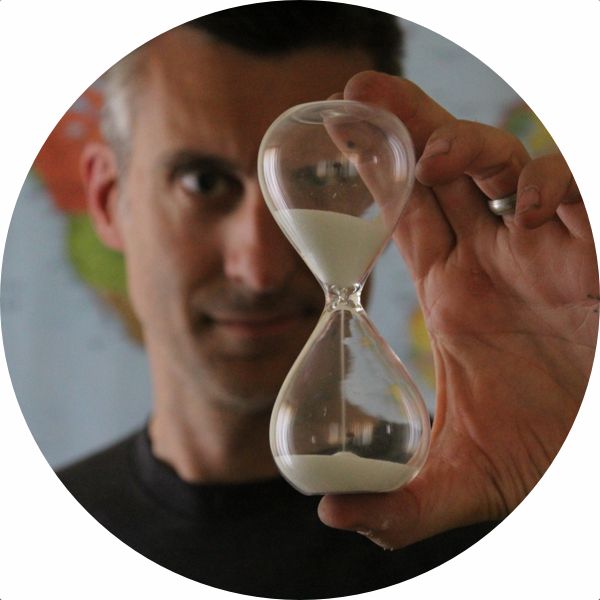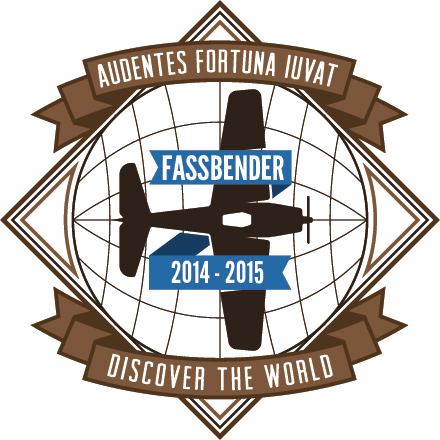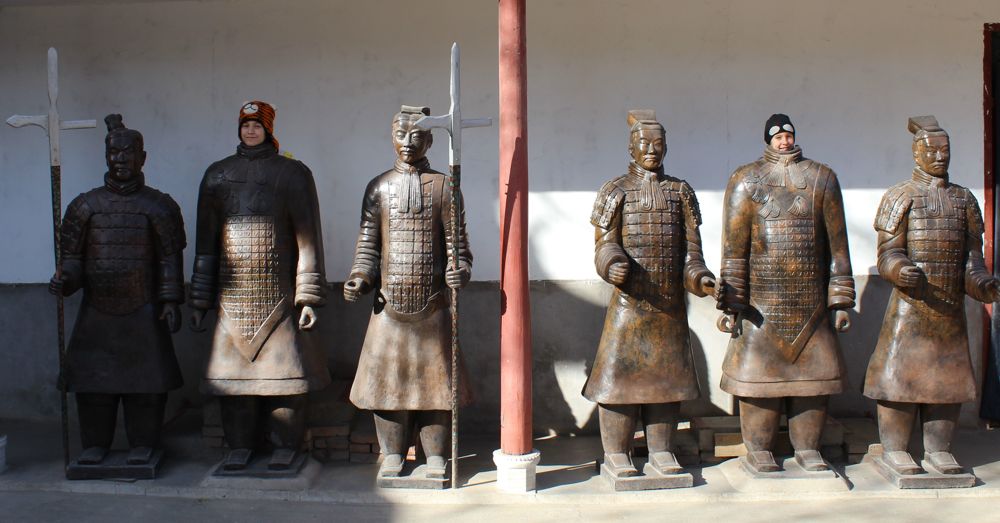Tuesday, 16-12-2014. Day 118.
A Many Thousand Man Army
After Chris (our guide to Xi'an) picked us up from the Xi'an Station, we went right to our hotel. Unlike most morning arrivals, we were able to check in right away when we entered, which was really nice — and the morning free breakfast was still available, which was even nicer (although as free breakfasts went, we ranked this one pretty low).
So after we ate, and freshened up a little bit in our hotel room, we met Chris back in the lobby and were soon off to see the first Qin Emperor's famous Terracotta Army but first, we had an obligatory stop the Terracotta Warrior Factory.
Terracotta Warrior Factory
Warriors.
Chris handed us off to a gent named Teddy who gave us a brief rundown on how they make their replica terracotta warriors and showed us all the different steps in action.
These are not the terracotta warriors we're looking for.
They make many different-sized terracotta warriors here, from small (table-top sized) to large (life-sized) in all the different styles: archer, warrior, commander, charioteer. You can even have your head photographed and have a life-sized replica terracotta warrior made with your likeness.
From the small workroom we were led into the large showroom, where everything was for sale. Teddy told us that if we wanted to buy anything, his shop was operated by the government so the quality of what he sells would be assured.
Mausoleum of the First Qin Emperor
We left the and took a short drive down the road to the Mausoleum of the First Qin Emperor (better known as the Terracotta Army), which is a UNESCO World Heritage site.
There are four different chambers that comprise the site, but the first chamber is the most impressive, with something like 6,000 figures in various states of excavation lined up in marching formation.
Terracotta Army, Chamber 1
There are three other excavation chambers with a smaller number of warriors. Chamber two holds 2,000 or so warriors and horses, and chamber three contained only 68 warriors, mostly officers, and four horses. There’s also a fourth chamber that’s remained largely unexcavated.
6,000 warriors ... every face is different.
Incredible detail behind each warrior.
While the sheer amount of work that went into making these figures is impressive enough, when you remember that each face is different (likely modeled on real members of the Emperor’s army), it’s pretty mind-blowing.
Horses!
As we looked at row upon row of terracotta warriors, some people visiting the site were more interested in photographing Frankie & Jackie than the terracotta warriors. Some even asked if they could have a picture with the kids.
A Chinese gent who wanted a picture with white kids.
After we finished with the four chambers, we had lunch at the restaurant (maybe there’s more than one, but we only know of the one), which was pretty good. They made noodle soup right there in front of you as you waited and it was pretty great.
After lunch, we checked out some of the other features of the site, like a a whole display of weapons that were found in the excavation. These were really well preserved, and it’s thought that some had been used in battle prior to the time of their burial (the late third century BCE).
Bronze Chariots
In addition to the impressive terracotta army, excavators found two chariots on the western slope. Each chariot is pulled by four horses, and unlike the terracotta army, these pieces are only half-size, likely because they are sculpted in bronze. These two sculptures, which are kept in their own darkened room, can never leave Chinese soil.
Bronze chariot and four horses.
Half-size horses and chariot.
On the way out we went through the gift shop and walked right by where the farmer who first found the Terracotta Army was sitting. You could have your photograph taken with him and have him sign the official book to commemorate your trip. The line to see him was pretty long, and we didn’t want a book (gotta keep our baggage wight down, you know), so we kept walking.
We leave the Terracotta Army behind.
Xi’an City Wall
From the Terracotta Army, we drove back into Xi’an and Chris took us to the Xi’an City Wall (a tentative UNESCO World Heritage site), the best preserved city fortification in China.
The wall, which is almost 14 kilometers around, was first built over the span of four years, starting in 194 BCE. Inside the city wall, building height is regulated — all the tall skyscrapers in Xi'an are outside the wall's perimeter.
It was pretty cool, and for something built from paving stones, really walkable. In addition to walking you can also rent a bike or take a tour along the wall in a big golf cart-looking thing. We just walked around for a little while. We could have gone on longer, but the sun was dropping and it was getting cold, so we headed back.
A Dinner Adventure
Chris dropped us off at the hotel and told us we’d start the next day at 9:00 a.m. That left us on our own for the evening. We’re not afraid to admit we had no idea what to do.
Chris did point us in the general direction of where some good restaurants might be, so we headed out to find a restaurant. Nothing quite matched what she had described to us, though. After a little searching, we managed to find a place down a side street that had some English on the street menu. So we went inside and took an elevator upstairs where we were seated and given menus.
But these menus had no English on them at all — and not a single picture. So we, with the help of the Google Translate app, told the waiter what we liked. We ordered noodles & dumplings, and he brought us a lot of noodles & dumplings. The food was good.
About half-way through the meal, we were a little worried about how much we were spending. Was this one of those places that lured tourists in, stuffed them with mounds of food, and then presented them with a huge bill? We hoped not …
When the bill did come, we had prepared ourselves for a budget-breaking dinner. We were surprised, then, when we saw the total was only $24 U.S.
It was our second best — and cheapest — meal in China. And we have no idea what it was called (there was a small sign over an archway that read Fu Jing Yuan, which means Fortune Garden—and there are a lot of those), but after a little research. we're reasonably sure it was Fu Bao Ge.
Notable Statistics
UNESCO World Heritage sites visited: 1 (14 cumulative)
Cats seen: 1
Dumplings eaten: 24

Tom Fassbender is a writer of things with a strong adventurous streak. When not adventuring, he’s been known to enjoy a cup of coffee or two. You can find him at Facebook and Instagram.
This post may include affiliate links which helps to support this site. As an Amazon Associate, we earn commission from qualifying purchases at no extra cost to you.




















